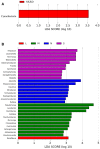Soil pH Is the Primary Factor Correlating With Soil Microbiome in Karst Rocky Desertification Regions in the Wushan County, Chongqing, China
- PMID: 29896164
- PMCID: PMC5987757
- DOI: 10.3389/fmicb.2018.01027
Soil pH Is the Primary Factor Correlating With Soil Microbiome in Karst Rocky Desertification Regions in the Wushan County, Chongqing, China
Abstract
Karst rocky desertification (KRD) is a process of land degradation, which causes desert-like landscapes, deconstruction of endemic biomass, and declined soil quality. The relationship of KRD progression with above-ground communities (e.g. vegetation and animal) is well-studied. Interaction of soil desertification with underground communities, such as soil microbiome, however, is vastly unknown. This study characterizes change in soil bacterial community in response to KRD progression. Soil bacterial communities were surveyed by deep sequencing of 16S amplicons. Eight soil properties, pH, soil organic matter (SOM), total and available nitrogen (TN and AN), total and available phosphorus (TP and AP), and total and available potassium (TK and AK), were measured to assess soil quality. We find that the overall soil quality decreases along with KRD progressive gradient. Soil bacterial community compositions are distinguishingly different in KRD stages. The richness and diversity in bacterial community do not significantly change with KRD progression although a slight increase in diversity was observed. A slight decrease in richness was seen in SKRD areas. Soil pH primarily correlates with bacterial community composition. We identified a core microbiome for KRD soils consisting of; Acidobacteria, Alpha-Proteobacteria, Planctomycetes, Beta-Proteobacteria, Actinobacteria, Firmicutes, Delta-Proteobacteria, Chloroflexi, Bacteroidetes, Nitrospirae, and Gemmatimonadetes in this study. Phylum Cyanobacteria is significantly abundant in non-degraded soils, suggesting that Cyanobacterial activities might be correlated to soil quality. Our results suggest that Proteobacteria are sensitive to changes in soil properties caused by the KRD progression. Alpha- and beta-Proteobacteria significantly predominated in SKRD compared to NKRD, suggesting that Proteobacteria, along with many others in the core microbiome (Acidobacteria, Actinobacteria, Firmicutes, and Nitrospirae), were active in nutrient limiting degraded soils. This study demonstrates the relationship of soil properties with bacterial community in KRD areas. Our results fill the gap of knowledge on change in soil bacterial community during KRD progression.
Keywords: Illumina HiSeq sequencing; driving factors; karst rocky desertification (KRD); soil bacteria; soil bacterial community; soil properties.
Figures




Similar articles
-
Soil nutrients, enzyme activities, and bacterial communities in varied plant communities in karst rocky desertification regions in Wushan County, Southwest China.Front Microbiol. 2023 Jun 14;14:1180562. doi: 10.3389/fmicb.2023.1180562. eCollection 2023. Front Microbiol. 2023. PMID: 37389350 Free PMC article.
-
Total nitrogen is the main soil property associated with soil fungal community in karst rocky desertification regions in southwest China.Sci Rep. 2021 May 24;11(1):10809. doi: 10.1038/s41598-021-89448-1. Sci Rep. 2021. PMID: 34031439 Free PMC article.
-
Karst rocky desertification progress: Soil calcium as a possible driving force.Sci Total Environ. 2019 Feb 1;649:1250-1259. doi: 10.1016/j.scitotenv.2018.08.242. Epub 2018 Aug 26. Sci Total Environ. 2019. PMID: 30308895
-
Water-soluble phosphorus contributes significantly to shaping the community structure of rhizospheric bacteria in rocky desertification areas.Sci Rep. 2019 Dec 5;9(1):18408. doi: 10.1038/s41598-019-54943-z. Sci Rep. 2019. PMID: 31804618 Free PMC article.
-
Impact of Rocky Desertification Control on Soil Bacterial Community in Karst Graben Basin, Southwestern China.Front Microbiol. 2021 Mar 10;12:636405. doi: 10.3389/fmicb.2021.636405. eCollection 2021. Front Microbiol. 2021. PMID: 33790877 Free PMC article.
Cited by
-
Synergistic effects of plant genotype and soil microbiome on growth in Lotus japonicus.FEMS Microbiol Ecol. 2024 Apr 10;100(5):fiae056. doi: 10.1093/femsec/fiae056. FEMS Microbiol Ecol. 2024. PMID: 38678008 Free PMC article.
-
Soil nutrients, enzyme activities, and bacterial communities in varied plant communities in karst rocky desertification regions in Wushan County, Southwest China.Front Microbiol. 2023 Jun 14;14:1180562. doi: 10.3389/fmicb.2023.1180562. eCollection 2023. Front Microbiol. 2023. PMID: 37389350 Free PMC article.
-
Root-Zone Restriction Regulates Soil Factors and Bacterial Community Assembly of Grapevine.Int J Mol Sci. 2022 Dec 9;23(24):15628. doi: 10.3390/ijms232415628. Int J Mol Sci. 2022. PMID: 36555269 Free PMC article.
-
Types of vegetables shape composition, diversity, and co-occurrence networks of soil bacteria and fungi in karst areas of southwest China.BMC Microbiol. 2023 Jul 19;23(1):194. doi: 10.1186/s12866-023-02929-3. BMC Microbiol. 2023. PMID: 37468849 Free PMC article.
-
Vertical Distribution of Soil Bacterial Communities in Different Forest Types Along an Elevation Gradient.Microb Ecol. 2023 Feb;85(2):628-641. doi: 10.1007/s00248-021-01949-8. Epub 2022 Jan 27. Microb Ecol. 2023. PMID: 35083529
References
-
- Ahmad M., Nadeem S. M., Naveed M., Zahir Z. A. (2016). Potassium-solubilizing bacteria and their application in agriculture, in Potassium Solubilizing Microorganisms for Sustainable Agriculture, eds Meena V. S., Maurya B. R., Verma J. P., Meena R. S. (New Delhi: Springer; ), 293–313.
-
- Aspiras R., Allen O., Chesters G., Harris R. (1971). Chemical and physical stability of microbially stabilized aggregates. Soil. Sci. Soc. Am. J. 35, 283–286. 10.2136/sssaj1971.03615995003500020030x - DOI
-
- Calò F., Parise M. (2006). Evaluating the human disturbance to karst environments in southern Italy. Acta Carsologica 35, 47–56. 10.3986/ac.v35i2-3.227 - DOI
-
- Chaparro J. M., Sheflin A. M., Manter D. K., Vivanco J. M. (2012). Manipulating the soil microbiome to increase soil health and plant fertility. Biol. Fertil. Soils 48, 489–499. 10.1007/s00374-012-0691-4 - DOI
LinkOut - more resources
Full Text Sources
Other Literature Sources
Miscellaneous

